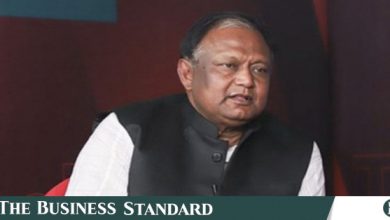Anti-India backlash sweeps Bangladesh in challenge for Modi


In the weeks since a student-led protest movement in Bangladesh swept out the government of Prime Minister Sheikh Hasina, discontent against her biggest ally in the region, India, has come bubbling to the surface.
On the streets of Dhaka, alongside triumphant protest slogans and colorful anti-Hasina murals, graffiti can be spotted mocking the ex-regime’s close ties to New Delhi. In Hasina’s burned-out family home, spray-painted messages cover the walls mocking the former prime minister for her closeness with India’s Narendra Modi.
And among ordinary Bangladeshis, resentment is palpable that Modi’s government has continued to shelter Hasina outside New Delhi for a month since she fled Dhaka in the face of deadly protests.
While Hasina’s ouster is a victory for Bangladesh’s student-led protest movement, it is a setback for India, South Asia’s dominant power, and marks the loss of a painstakingly cultivated regional ally. Under Hasina, Bangladesh rooted out Islamic terrorist groups, and anti-India militants. As trade links between the two countries blossomed, India ignored Hasina’s authoritarian turn — calling her crackdown on protesters an “internal matter”— and tried to shield her government from international criticism.
“India is extremely unpopular in Bangladesh. All the unpopularity against Hasina is now being transferred to India,” said Sushant Singh, a lecturer at Yale University. The new regime in Bangladesh, he said, “will have to be significantly different in their approach and outreach to India because otherwise they will be pilloried.”
The collapse of Hasina’s government now adds to a growing list of security worries for Modi in India’s backyard. They include a new pro-China government in the Maldives, a spike in militant attacks in Pakistan and a long-running border standoff with China.
There are signs, meanwhile, of growing weariness with India’s heavy-handed policies toward its neighbors — manifesting most recently in an open letter published in August by a group of five prominent citizens from Bangladesh, Sri Lanka and Nepal. They urged India from interfering in the domestic politics of their countries.
New Delhi hasn’t directly addressed the recent wave of anti-India sentiment in Bangladesh, but has pledged to work with the new interim administration headed by Nobel laureate Muhammad Yunus. Modi, meanwhile, has continued to highlight attacks targeting Bangladesh’s Hindu minority population there.
Yunus has voiced his disapproval of India allowing Hasina to stay in the country while she continues to make political comments about Bangladesh. She needs to be returned to the country to face criminal charges, he said.
“Sitting in India, she is speaking and giving instructions,” he said in an interview with Press Trust of India. “No one likes it.”
For relations between the two countries to improve, India will need to drop its narrative that everyone in Bangladesh is an Islamist and the country is only safe with Hasina at the helm, Yunus said.
India’s friendly links to Bangladesh stretch back to 1971, when India intervened to assist in its war of independence from Pakistan. Under Hasina, Bangladesh and India forged strong economic and defense ties, with Hasina cracking down on Islamic militants in the country and banning the country’s main right-wing Islamic political party from participating in national elections — a ban since reversed.
Hasina also advanced the key Indian security goal of flushing out separatist groups fighting in India’s northeastern states and hiding out in Bangladesh. India’s isolated northeast is joined to the rest of the country by a narrow strip of land encircling Bangladesh known as India’s “chicken’s neck,” and a friendly government in Dhaka helped Indian ensure security in the vulnerable region. This year, Hasina canceled the Bangladesh military’s first-ever planned exercise with China with New Delhi’s sensitivities in mind.
India’s support for Hasina in turn made Bangladesh into an important strategic counterweight to New Delhi’s two biggest regional rivals: Pakistan and China. It also took a load off India’s military, which is already stretched patrolling disputed territory on multiple borders with both rivals.
India’s military had 195,000 vacancies in 2022, with another 60,000 arising every year due to early retirements and other reasons, according to government figures. Those deployed remain tied up guarding India’s numerous border disputes — from Kashmir on its frontier with Pakistan, to multiple disputed borders in its mountainous north with China.
Analysts and officials say that whatever government succeeds Yunus will face little choice but to reassess ties with India.
“India has to rethink its politics,” said Rizwana Hasan, an adviser to Bangladesh’s interim government. “It’s for India to think about what went wrong for the people of Bangladesh to react so sharply against them.”
With Hasina’s fall, risks for New Delhi include the extent that the next government in Bangladesh pushes back, and whether it continues to draw closer to China. Another worry is the prospect of deeper instability in Bangladesh that gives militant groups room to maneuver, or that sends refugees pouring into India.
Yunus told Indian broadcaster NDTV last month that deeper instability could lead to a “volcanic eruption” that puts several regions at risk, including in India’s northeast, in its border state of West Bengal, and on Bangladesh’s border with Myanmar. India’s Border Security Force has been on high alert since Hasina’s government collapsed and turned away hundreds of Bangladeshi citizens trying to cross into the country.
“We do not know how India and Bangladesh will manage the boundary dispute, how they will manage migration,” said Harsh Pant, vice president of studies and foreign policy at the Observer Research Foundation, a New Delhi think tank. “If you do not have a mature partner it becomes difficult to navigate these issues.”
Disclaimer: This article first appeared on Bloomberg and is published by a special syndication arrangement.




